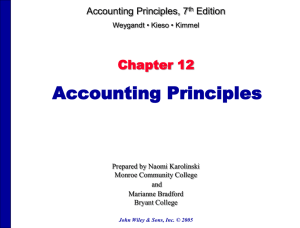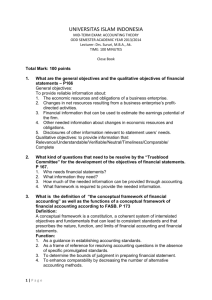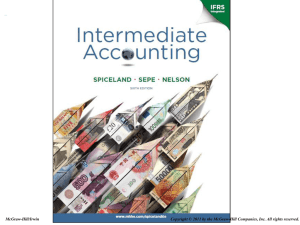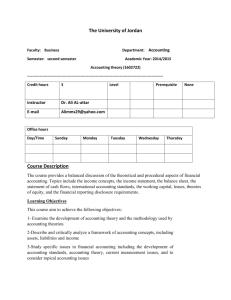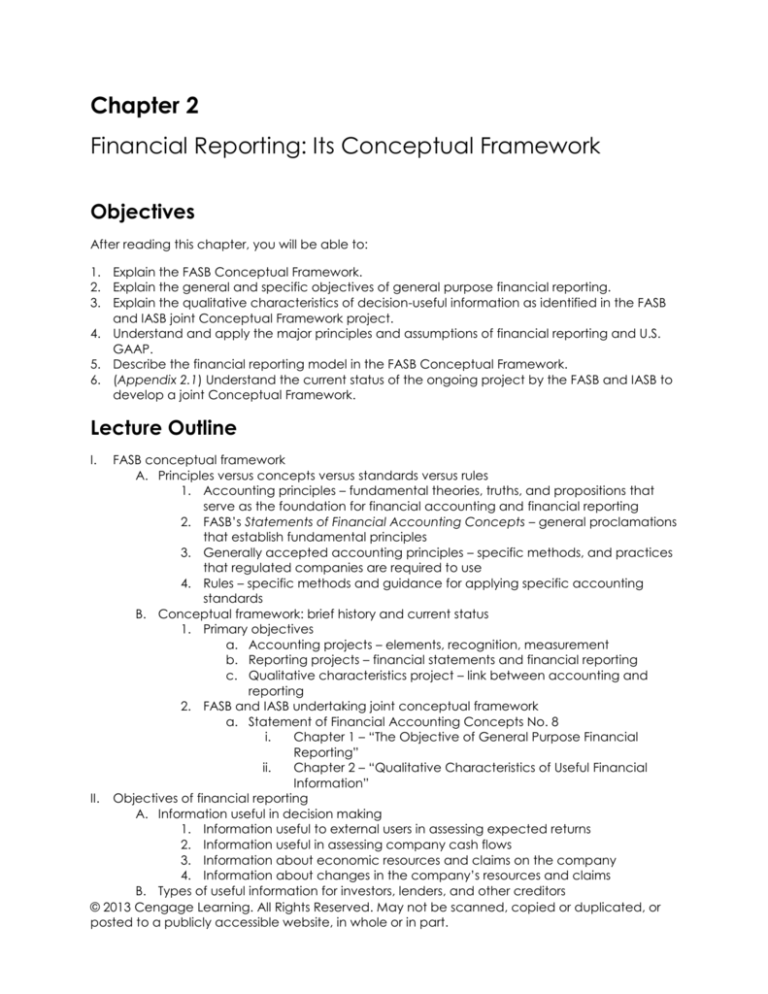
Chapter 2
Financial Reporting: Its Conceptual Framework
Objectives
After reading this chapter, you will be able to:
1. Explain the FASB Conceptual Framework.
2. Explain the general and specific objectives of general purpose financial reporting.
3. Explain the qualitative characteristics of decision-useful information as identified in the FASB
and IASB joint Conceptual Framework project.
4. Understand and apply the major principles and assumptions of financial reporting and U.S.
GAAP.
5. Describe the financial reporting model in the FASB Conceptual Framework.
6. (Appendix 2.1) Understand the current status of the ongoing project by the FASB and IASB to
develop a joint Conceptual Framework.
Lecture Outline
I.
FASB conceptual framework
A. Principles versus concepts versus standards versus rules
1. Accounting principles – fundamental theories, truths, and propositions that
serve as the foundation for financial accounting and financial reporting
2. FASB’s Statements of Financial Accounting Concepts – general proclamations
that establish fundamental principles
3. Generally accepted accounting principles – specific methods, and practices
that regulated companies are required to use
4. Rules – specific methods and guidance for applying specific accounting
standards
B. Conceptual framework: brief history and current status
1. Primary objectives
a. Accounting projects – elements, recognition, measurement
b. Reporting projects – financial statements and financial reporting
c. Qualitative characteristics project – link between accounting and
reporting
2. FASB and IASB undertaking joint conceptual framework
a. Statement of Financial Accounting Concepts No. 8
i.
Chapter 1 – “The Objective of General Purpose Financial
Reporting”
ii.
Chapter 2 – “Qualitative Characteristics of Useful Financial
Information”
II. Objectives of financial reporting
A. Information useful in decision making
1. Information useful to external users in assessing expected returns
2. Information useful in assessing company cash flows
3. Information about economic resources and claims on the company
4. Information about changes in the company’s resources and claims
B. Types of useful information for investors, lenders, and other creditors
© 2013 Cengage Learning. All Rights Reserved. May not be scanned, copied or duplicated, or
posted to a publicly accessible website, in whole or in part.
Chapter 2: Financial Reporting: Its Conceptual Framework
Instructor’s Manual, p. 2
1. Return on investment – measure of overall company performance for equity
shareholders
2. Risk – uncertainty or unpredictability of future profitability
3. Financial flexibility – ability to use financial resources to adapt to change or
take advantage of opportunities
4. Liquidity – how quickly assets can be converted to cash to meet short-term
obligations and cover operating costs
5. Operating capability – ability to produce goods and services for customers
III. Qualitative characteristics of useful accounting information
A. Decision usefulness – ultimate objective
1. Relevance – capable of making a difference in decisions
a. Predictive value – helps form expectations about future
b. Confirmatory value – provides feedback to confirm or correct prior
predictions and expectations
c. Materiality – nature and magnitude of omission or misstatement that
would influence judgment of reasonable person relying on information
2. Faithful representation – accurately depict economic substance of what they
purport to represent
a. Complete – full disclosure of all necessary information
b. Neutral – not biased to achieve a predetermined result or influence
behavior in a particular direction
c. Free from error – measured and described as accurately as possible
3. Relation between relevance and faithful representation
a. Not necessarily tradeoffs – one may not have to be sacrificed for the
other
B. Enhancing characteristics
1. Comparability – intercompany and intracompany
a. Consistency – methods and procedures applied in same manner from
period to period – quality of the accounting process
2. Verifiability – different knowledgeable and independent observers can reach
consensus
3. Timeliness – available in time to influence decision
4. Understandability – comprehensible to users who have reasonable
knowledge of business and economic activities
5. Cost constraint – pervasive – benefits of information must exceed costs of
providing
IV. Accounting assumptions and principles
A. Reporting entity – business enterprise is a legally and economically distinct entity
B. Going-concern assumption (continuity assumption) – company will continue to
operate in foreseeable future
C. Period of time – prepare reports at end of each year to provide timely information
D. Monetary unit – national currency of reporting entity – assumed to be stable over
time
E. Mixed attribute measurement – use most relevant and representationally faithful
measurement available
1. Historical cost (exchange price) – at time of transaction – can lose relevance
over time
2. Fair value – when more relevant and can be faithfully represented
3. Present value – when future cash flows involved
4. Net realizable value – when there has been a decline in value
F. Recognition – process of formally recording and reporting an item – criteria:
1. Meets definition of element
© 2013 Cengage Learning. All Rights Reserved. May not be scanned, copied or duplicated, or
posted to a publicly accessible website, in whole or in part.
Chapter 2: Financial Reporting: Its Conceptual Framework
Instructor’s Manual, p. 3
2. Measurable
3. Relevant
4. Representationally faithful
G. Accrual accounting
1. Revenue recognition principle – inflows of assets and settlements of
obligations from selling goods and providing services to customers in a
particular period
2. Expense recognition principle – recognize expense on basis of three methods:
a. Cause and effect – matching principle
b. Immediate consumption
c. Systematic and rational allocation over time
H. Conservatism (prudence) – avoid overstating net assets and net income when
amounts are uncertain
V. The financial reporting model in the conceptual framework
A. Four specific financial statements
1. Balance sheet
2. Income statement
3. Statement of cash flows
4. Statement of shareholders’ equity
B. Notes to financial statements (and parenthetical disclosures)
C. Supplementary information
D. Other means of reporting – management discussion and analysis
E. Other information
VI. Appendix 2.1: Status of the joint FASB and IASB conceptual framework project
A. Goal – a joint conceptual framework that is complete and internally consistent – split
into eight phases
B. Phase one: objective and qualitative characteristics
1. Issued joint statement – Statement of Financial Accounting Concepts No. 8 –
September 2010
a. Supersedes FASB Concept Statements No. 1 and No. 2
C. Ongoing phases – active, but on hold
1. Phase two: elements and recognition – refining and improving definitions of
assets and liabilities
2. Phase three: measurement – evaluating various measurement techniques for
assets and liabilities
3. Phase four: reporting entity – tentative definition
Synopsis
FASB Conceptual Framework
The SEC charged the FASB with developing a conceptual framework for financial accounting
and with establishing standards for financial accounting practice. The Conceptual Framework
was developed by the FASB as a theoretical foundation of interrelated objectives, concepts,
principles, and definitions that leads to the establishment of consistent high-quality financial
accounting standards and the appropriate application of those standards in accounting
practice.
Accounting principles are fundamental theories, truths, and propositions that serve as the
foundation for financial accounting and financial reporting. The FASB’s Statements of Financial
© 2013 Cengage Learning. All Rights Reserved. May not be scanned, copied or duplicated, or
posted to a publicly accessible website, in whole or in part.
Chapter 2: Financial Reporting: Its Conceptual Framework
Instructor’s Manual, p. 4
Accounting Concepts (Concepts Statements) are necessarily broad, deep, and general
proclamations that establish:
Fundamental principles of accounting
Objectives of financial reporting
Qualities of useful financial accounting information
Definitions of basic elements like assets and liabilities
Types of economic transactions, events, and arrangements to be recorded in financial
statements
Measurement attributes to use to measure and report these transactions, events, and
arrangements
How transactions, events, and arrangements should be presented and classified in financial
statements
Concept Statements are not GAAP, but form the basis and objectives of GAAP. GAAP are
specific standards, methods, and practices that regulated companies are required to use in
preparing and reporting specific items of accounting information in financial statements for use
by external stakeholders and decision makers.
Rules are typically written within standards. Rules represent specific implementation guidelines.
The FASB divided its initial Conceptual Framework activities into several projects. The first project
resulted in Statement of Financial Accounting Concepts No. 1, “Objectives of Financial
Reporting for Business Enterprises,” issued in 1978. This established the focus of the remaining
projects which were divided into accounting and reporting groups. The qualitative
characteristics project linked the accounting and reporting projects together and resulted in
Statement of Financial Accounting Concepts No. 2, “Qualitative Characteristics of Accounting
Information,” issued in 1980.
The accounting projects define accounting elements, identify which elements should be
recognized in financial statements, when they should be reported, and how they should be
measured. The reporting projects deal with how elements are classified and presented in
financial statements, what information should be provided, and where the information should
be presented.
The FASB and IASB are developing a joint Conceptual Framework. The objective is to provide a
sound foundation for both Boards to develop future accounting standards. The FASB and IASB
issued Statement of Financial Accounting Concepts No. 8, “Conceptual Framework for Financial
Reporting.” Chapter 1 is titled “The Objectives of General purpose Financial Reporting,” and
Chapter 3 is titled “Qualitative Characteristics of Useful Financial Information.” These two
chapters supersede FASB Concepts Statements No. 1 and No. 2.
Relevant Examples and Exhibits
Exhibit 2.1 Relationship of FASB Conceptual Framework and Standard-Setting Process
Exhibit 2.2 Conceptual Framework Projects for Financial Accounting and Reporting
Objectives of Financial Reporting
The primary objective of financial reporting is to provide useful information about the reporting
entity for existing and potential investors, lenders, and other creditors in making decisions about
providing resources to the entity.
© 2013 Cengage Learning. All Rights Reserved. May not be scanned, copied or duplicated, or
posted to a publicly accessible website, in whole or in part.
Chapter 2: Financial Reporting: Its Conceptual Framework
Instructor’s Manual, p. 5
External users need information to assess expected returns from their investment in an entity.
They are interested in the amounts, timing, and uncertainty of cash flows they will receive.
External users also need information to assess company cash flows. They are interested in the
amounts, timing, and uncertainty of the prospective net cash inflows to the company.
One specific objective of financial reporting is to provide information about a company’s
economic resources and the claims on the company.
Another specific objective of financial reporting is to provide information about the financial
performance, as well as other transactions and events, which cause the company’s resources
and the claims on the company to change during the period.
Comprehensive income should measure and report the economic resources the company has
generated and consumed during the period. Accrual accounting is a method of accounting
that measures and reports the economic effects of a company’s transactions, events, and
circumstances on a company’s economic resources and claims in the periods in which those
effects occur, even if the related cash receipts and payments occur in a different period.
A final specific objective of financial reporting is to provide information about how a company’s
cash flows cause changes in the company’s resources and claims.
Another important objective implied in assessing a company’s prospects for future cash inflows is
providing information about how efficiently and effectively the company’s management and
governing boards have discharged their responsibilities to use the company’s resources.
The following types of information are helpful in assessing the amounts, timing, and uncertainty
of expected future cash flows to a company:
Return on investment – serves as useful information to investors, lenders, and other creditors in
providing a measure of overall company profitability and performance.
Risk – the uncertainty or unpredictability of the future results of a company.
Financial flexibility – the ability of a company to use its financial resources to adapt to
change and to take advantage of opportunities.
Liquidity – a characteristic of an asset that refers to how quickly a company can convert
that asset into cash to meet short-term obligations and cover operating costs.
Operating capability – the ability of a company to produce goods and services for
customers.
Relevant Examples and Exhibits
Example 2.3 Objectives of Financial Reporting
Qualitative Characteristics of Useful Accounting Information
Decision usefulness is the overall qualitative characteristic that is the ultimate objective of
accounting information. The goal of decision usefulness can be achieved if the accounting
information possesses the fundamental qualitative characteristics of relevance and faithful
representation.
Relevance is a primary attribute of accounting information that indicates it is capable of making
a difference in decisions made by financial statement users. Financial information is capable of
making a difference if the information is capable of helping users predict future outcomes and
/or confirm or correct prior expectations, and the information is material in nature and amount.
© 2013 Cengage Learning. All Rights Reserved. May not be scanned, copied or duplicated, or
posted to a publicly accessible website, in whole or in part.
Chapter 2: Financial Reporting: Its Conceptual Framework
Instructor’s Manual, p. 6
Predictive value is an attribute of accounting information that should help users form
expectations about the future. Confirmatory value is an attribute of accounting information that
provides feedback to confirm or correct prior predictions and expectations. Materiality refers to
the nature and magnitude of an omission or misstatement of accounting information that would
influence the judgment of a reasonable person relying on that information. Materiality is an
entity specific aspect of relevance and companies should consider the nature of the item and
its relative size.
Accounting information is a faithful representation of the underlying economic transactions,
events, and arrangements when the words and numbers depict the economic substance of
what they purport to represent. To be a faithful representation, the information must be
complete, neutral, and free from error.
Accounting information is complete if it provides a user with full disclosure of all the information
necessary to understand the information being reported, with all necessary facts, descriptions,
and explanations. Neutral is an aspect of accounting information that is not biased, slanted,
emphasized, or otherwise manipulated to achieve a predetermined result or to influence users’
behavior in a particular direction. Free from error is an aspect of accounting information that
means the information is presented as accurately as possible, using a process that reflects the
best available inputs.
Accounting information is most useful when it is both relevant and faithfully represented.
Relevance and faithful representation are not necessarily tradeoffs.
The FASB and IASB describe the following characteristics that enhance the decision usefulness of
information that is relevant and faithfully represented:
Comparability is the aspect of accounting information that enables users to identify and
explain similarities and differences between two or more sets of economic facts. This can
involve comparisons with other companies or within the same company across time.
Consistency is the aspect of accounting information that means accounting methods and
procedures are applied in the same manner from period to period.
Verifiable is the aspect of accounting information that means when different
knowledgeable and independent observers can reach consensus (but not necessarily
complete agreement), a particular representation is faithful.
Timely is the aspect of accounting information that means it is available to decision makers
in time to influence their decision.
Understandability is the aspect of accounting information that means it should be
comprehensible to users who have reasonable knowledge of business and economic
activities and who are willing to study the information carefully.
Cost constraint is a constraint on identifying what information should be disclosed in financial
reports and is based on the costs of collecting, processing, auditing, and communicating the
information and possibly the risk of losing a competitive advantage by disclosing such
information. The costs of providing the information should not exceed the benefits received
from using the information.
Relevant Examples and Exhibits
Exhibit 2.4 Tentative FASB and IASB Joint Conceptual Framework
Accounting Assumptions and Principles
The following accounting assumptions and principles have had an important impact on the
development of GAAP:
© 2013 Cengage Learning. All Rights Reserved. May not be scanned, copied or duplicated, or
posted to a publicly accessible website, in whole or in part.
Chapter 2: Financial Reporting: Its Conceptual Framework
Instructor’s Manual, p. 7
Reporting entities are business enterprises, whether proprietorships or partnerships or
corporations, that generate economic activity. Accounting assumes that a business
enterprise is a legally and economically distinct entity, so that financial statements can be
prepared and reported specifically for that entity.
Going-concern assumption (continuity assumption) is the assumption that a company will
continue to operate in the foreseeable future, unless substantial evidence to the contrary
exists.
Period-of-time assumption is the assumption companies operate under in that they prepare
and report financial statements at the end of each year and include them in an annual
report and in annual filings with the SEC. An accounting period (fiscal year) is the annual
reporting period whether calendar year or fiscal year. While most companies adopt the
calendar year, some choose a fiscal year that approximates their business cycle, which is
the yearly period from lowest sales through highest sales and back to lowest sales.
Monetary unit of measurement is the national currency of the reporting company used in
preparing financial statements. Accountants assume that this monetary unit is stable over
time.
Mixed attribute measurement model is the reporting model that measures assets, liabilities,
revenues, expenses, and other elements of the financial statements based on the most
relevant and faithful measurement available. Economic activities and resources of a
company initially are measured using the exchange price at the time the transaction occurs.
Historical cost (exchange price) is the most relevant and a faithful representation of the
value of an exchange and offers evidence that independent parties have willingly agreed
on the value of the items exchanged at the time of the transaction, thus reflecting the
qualities of relevance, representational faithfulness (neutrality), and verifiability.
Accounting standards sometimes require the use of valuation methods other than historical
cost. Some examples are fair value, present value, and net realizable value.
Recognition is the process of formally recording and reporting an item in the financial
statements of a company. The FASB identified four fundamental recognition criteria. The
item must: meet the definition of an element, be measurable, be relevant, and be
representationally faithful.
Accrual accounting is the process of measuring and reporting the economic effects of
transactions, events, and circumstances in the appropriate period when those effects occur,
even though the related cash flows may occur in a different period. Accruals result in
economic effects being recognized in the current period, even though the cash flows will
occur in a later period. Deferrals result in economic effects recognized in a later period
though the cash flows occur in the current period.
The revenue recognition principle is an application of accrual accounting that determines
the appropriate period in which a company creates economic benefits and can recognize
revenues in income. The expense recognition principle is an application of accrual
accounting that determines the appropriate period in which a company has consumed
economic resources in conducting business operations. The following three methods for
expenses recognition are typical: cause and effect, immediate consumption, and
systematic and rational allocation over time. The matching principle is a principle that
attempts to match the expense to the period in which the economic benefits are created.
The matching principle is an example of cause and effect expense recognition.
Conservatism is an approach where when accounting valuations are uncertain and
alternative accounting valuations for assets or liabilities are equally possible, the accountant
selects the one that is least likely to overstate the company’s assets and income in the
© 2013 Cengage Learning. All Rights Reserved. May not be scanned, copied or duplicated, or
posted to a publicly accessible website, in whole or in part.
Chapter 2: Financial Reporting: Its Conceptual Framework
Instructor’s Manual, p. 8
current period. While conservatism is typically not established in GAAP, it can and often
does affect accounting practice.
Conservatism is sometimes described as prudence, which is an attribute of the accounting
practice of conservatism where the uncertainties and risks inherent in business situations are
adequately considered.
Relevant Examples and Exhibits
Exhibit 2.5 Framework of Financial Accounting Theory and Practice
The Financial Reporting Model in the Conceptual Framework
The FASB identified five sources of information used in external decision making as follows:
Financial statements – balance sheet, income statement, cash flows, and statement of
shareholders’ equity.
Notes to financial statements and parenthetical disclosures.
Supplementary information.
Other means of financial reporting – management discussion and analysis.
Other information.
Relevant Examples and Exhibits
Exhibit 2.6 Sources of Information Used in External Decision Making
Appendix 2.1: Status of the Joint FASB and IASB Conceptual Framework Project
The goal of the Boards is to develop a joint Conceptual Framework that is both complete and
internally consistent. The project was split into the following eight phases:
Objective and qualitative characteristics
Elements and recognition
Measurement
Reporting entity
Presentation and disclosure
Framework for a GAAP hierarchy
Applicability to the not-for-profit sector
Remaining issues
A joint statement was issued in September 2010 upon completion of the first phase. Statement
of Financial Accounting Concepts No. 8 is titled “Conceptual Framework for Financial
Reporting.” It contains two chapters. Chapter 1 is titled “The Objective of General purpose
Financial Reporting,” and Chapter 3 is titled “Qualitative Characteristics of Useful Financial
Information.”
The Boards have temporarily placed the Conceptual Framework project on hold while they
focus on finalizing convergence on several major specific standards. The following three phases
were active when the project was placed on hold:
Phase Two: Elements and Recognition
Phase Three: Measurement
Phase Four: Reporting Entity
Ethical Dilemma Answer
© 2013 Cengage Learning. All Rights Reserved. May not be scanned, copied or duplicated, or
posted to a publicly accessible website, in whole or in part.
Chapter 2: Financial Reporting: Its Conceptual Framework
Instructor’s Manual, p. 9
This ethical dilemma allows the student to apply the conceptual framework to a property, plant
and equipment valuation judgment. Management’s decision would be a clear violation of the
historical cost principle. However, class discussion can be stimulated by expanding the
discussion to include the tradeoff between relevance and faithful representation. In the typical
setting, PP&E items are not intended to be sold and the relevance of fair value information may
not outweigh the representational faithfulness inherent in historical cost information. In the
merger context, the fair value information may be the most relevant information to market
participants. In addition, the faithful representation of the fair value information is greatly
enhanced by the periodic valuations by independent appraisals. Therefore, management’s
argument that the information is relevant and faithfully represented does have merit. Many
students may take issue that GAAP will not allow upward revaluations of assets when more
relevant information can be faithfully represented, even though downward revaluations
(impairments) are an established part of GAAP. The discussion can also expand to include the
increased use of fair value measurements in recent FASB standards.
Instructional Notes
Students should have an appreciation for the FASB Conceptual Framework and its
interrelationship with and impact on the standard-setting process. Exhibit 2.1 can be a resource
to assist with illustrating these relationships. It is important for the students to understand that the
Conceptual Framework is not GAAP and is not included in the FASB Codification. However, the
Conceptual Framework is essential to the development of any new Accounting Standards
Updates that become part of the FASB Codification.
Students often get so involved in the mechanics of financial reporting that they lose sight of why
the information is needed. Exhibit 2.3 should help students focus on the objectives associated
with the information contained in the financial reports. By focusing on the primary objective,
they will understand that the reports are primarily used by external parties. You can further help
them obtain this focus by looking at the types of information that are useful for these parties:
return on investment, risk, financial flexibility, liquidity, and operating capability.
The qualitative characteristics of accounting information have changed with the joint
Conceptual Framework. Exhibit 2.4 should help identify some of those changes and allow you to
help students understand the fundamental concepts of relevance and faithful representation.
You can also highlight the enhancing characteristics and the cost/benefit constraint.
The accounting principles and assumptions discussed in this chapter will be utilized in many
subsequent chapters. Exhibit 2.5 will help students understand how these fit within the framework
of accounting theory and practice.
This chapter discusses the foundations of accrual accounting and should help the students
understand the concepts of accruals and deferrals. Helping them get a firm understanding of
revenue and expense recognition will assist them when these topics are addressed later in the
textbook.
Exhibit 2.6 provides a good overview of the various types of information used by external
decision makers. Helping the students understand that the financial reporting process includes
informative disclosures beyond the basic financial statements can be emphasized.
Students should be aware of the joint Conceptual Framework and the current status of work in
this area as the FASB and IASB continue to work on convergence of accounting standards.
© 2013 Cengage Learning. All Rights Reserved. May not be scanned, copied or duplicated, or
posted to a publicly accessible website, in whole or in part.



